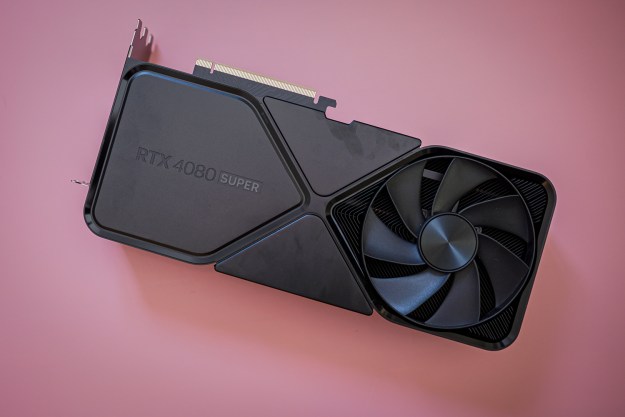Nvidia was recently hacked, and as a result, plenty of inside information has surfaced. A lot of the leaks are related to the upcoming next-generation RTX 4000 graphics cards, and today’s leaks point to a massive performance jump from the RTX 3000 family of GPUs — and when we say massive, we really do mean massive, in the ballpark of twice as powerful as the graphics cards we’re using today.
This performance boost, if proven to be true, will stem from huge hardware upgrades. According to the leaks, the flagship Ada GPU may have up to 75% more cores than the RTX 3090, and the entire lineup will have a massive L2 cache.
J'ai fait un petit graphique pic.twitter.com/zilwXgi0va
— La Frite David 🇫🇷 (@davideneco25320) March 1, 2022
There’s a lot to unpack in today’s round of leaks, so let’s start with the basics — Nvidia RTX 4000-series is looking at some huge performance jumps compared to the graphics cards we’re using today. Improvements are to be expected going from one gen to the next, but there’s a possibility of reaching previously unheard-of levels of performance, especially with the top Nvidia Ada Lovelace GPUs.
Perhaps the most important rumor stems from the chip used in the Ada GPUs. Purportedly, Nvidia is switching from Samsung to TSMC for its new process nodes and will utilize the latest N5 5nm node. This should translate to an improvement in both efficiency and performance.
Ada will have huge L2 @VideoCardz pic.twitter.com/sjMGXttX0Y
— XinoAssassin (@xinoassassin1) March 2, 2022
The leaked Nvidia files revealed the company’s naming convention for the upcoming GPUs, keeping the current Ampere nomenclature much the same. The flagship GPU will be called AD102 and will be found inside the top-tier graphics cards, probably named RTX 4090. It will be followed by AD103 as the next-best pick, AD104-106 as the mid-range options, and AD107 for the budget segment, likely the equivalent of the current-gen RTX 3050. Nvidia seems to be sticking to Ada for the codename of the new GPU family.
According to davidneco25320 on Twitter, a large leap is expected in terms of the number of streaming processors (SMs) found in Ada GPUs. The leaker shared a full list of GPU dies and their expected SM count. The flagship AD102 is said to feature up to 144 SMs in a single die, which is a massive increase over the current RTX 3090 flagship, which has 84 SMs. As Tom’s Hardware reports, this is a 71% increase between the RTX 3090 and the RTX 4090, potentially leading to huge performance gains. This also implies similar gains to GPU cores, ray-tracing cores, and other elements.
Tom’s Hardware also speculates that we may be seeing a huge upgrade in CUDA cores. Nvidia’s RTX 3090 currently has 10,752 CUDA cores, which is already enormous, but Ada’s top GPU could bring that number up to 18,432. There has been no information about the core count on the lower-tier Ada GPUs, but the list reveals that the AD103 will have 84 SMs, a 40% increase from the current-gen equivalent. Nvidia is also rumored to go up a generation in terms of tensor cores and ray-tracing cores, switching from 3rd and 2nd gen to 4th and 3rd respectively.

VideoCardz has also shared some fascinating leaks about the GPUs, all coming from Twitter users harukaze5719, kopite7kimi, and xinoassassin1. According to these leaks, the Nvidia RTX 4000-series GPUs will have a huge L2 cache, much larger than the one found in the current generation.
The Ampere cards that currently top the list of the best GPUs for Nvidia feature 512KB of cache per 32-bit memory bus. However, the new data confirm that Ada GPUs will have 16MB of cache per 64-bit memory bus, adding up to 96MB of L2 cache in the top graphics card.
The leaks come from various Twitter sources, and some of these users are known for accurate hardware leaks. However, we can’t confirm the validity of these claims until Nvidia itself talks about the Ada GPU architecture, so take it with a healthy dose of skepticism. On the other hand, given the number of different voices that all claim various huge improvements in the RTX 4000 lineup, it’s becoming clear that we’re looking at a huge performance boost compared to current-gen cards.
Whether every single piece of information shared by the leakers is correct or not is irrelevant at this point — it’s pretty safe to assume that the generational gap between the RTX 3000 and the RTX 4000 GPUs will be large. Of course, this will vary based on the model, and we won’t really know more for a while yet.
Editors' Recommendations
- RTX 4090 owners are in for some bad news
- Nvidia RTX 50-series graphics cards: news, release date, price, and more
- Nvidia just made GeForce Now so much better
- Why I’m feeling hopeful about Nvidia’s RTX 50-series GPUs
- CableMod’s adapters damaged up to $74K worth of Nvidia GPUs



